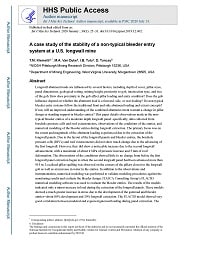Mining Publication: A Case Study of the Stability of a Non-typical Bleeder Entry System at a U.S. Longwall Mine
Original creation date: January 2020
Authors: T Klemetti, M Van Dyke, I Tulu, D Tuncay
Longwall abutment loads are influenced by several factors, including depth of cover, pillar sizes, panel dimensions, geological setting, mining height, proximity to gob, intersection type, and size of the gob. How does proximity to the gob affect pillar loading and entry condition? Does the gob influence depend on whether the abutment load is a forward, side, or rear loading? Do non-typical bleeder entry systems follow the traditional front and side abutment loading and extent concepts? If not, will an improved understanding of the combined abutment extent warrant a change in pillar design or standing support in bleeder entries? This paper details observations made in the non-typical bleeder entries of a moderate depth longwall panel–specifically, data collected from borehole pressure cells and roof extensometers, observations of the conditions of the entries, and numerical modeling of the bleeder entries during longwall extraction. The primary focus was on the extent and magnitude of the abutment loading experienced due to the extraction of the longwall panels. Due to the layout of the longwall panels and bleeder entries, the borehole pressure cells (BPCs) and roof extensometers did not show much change due to the advancing of the first longwall. However, they did show a noticeable increase due to the second longwall advancement, with a maximum of about 4 MPa of pressure increase and 5 mm of roof deformation. The observations of the conditions showed little to no change from before the first longwall panel extraction began to when the second longwall panel had been advanced more than 915 m. Localized pillar spalling was observed on the corners of the pillars closest to the longwall gob as well as an increase in water in the entries. In addition to the observations and instrumentation, numerical modeling was performed to validate modeling procedures against the monitoring results and evaluate the bleeder design. ITASCA Consulting Group’s FLAC3D numerical modeling software was used to evaluate the bleeder entries. The results of the models indicated only a minor increase in load during the extraction of the longwall panels. These models showed a much greater increase in stress due to the development of the gateroad and bleeder entries—about 80% development and 20% longwall extraction. The FLAC3D model showed very good correlation between modeled and expected gateroad loading during panel extraction. The front and side abutment extent modeled was very similar to observations from this and previous panels.

- A Case Study of Multi-Seam Coal Mine Entry Stability Analysis with Strength Reduction Method
- Computational Fluid Dynamics Modeling of Spontaneous Heating in Longwall Gob Areas
- Effect of Longwall Face Advance on Spontaneous Heating in Longwall Gob Areas
- Effects of Ventilation and Gob Characteristics on Spontaneous Heating in Longwall Gob Areas
- Multiple-Seam Mining in the United States: Background
- A New Method to Calculate Permeability of Gob for Air Leakage Calculations and for Improvements in Methane Control
- Numerical Study on Effects of Coal Properties on Spontaneous Heating in Longwall Gob Areas
- Pillar Strength and Design Methodology for Stone Mines
- Simplified Pre- and Post-Processing Technique for Performing Finite-Element Analyses of Deep Underground Mines
- Simulation of Spontaneous Heating in Longwall Gob Area with a Bleederless Ventilation System